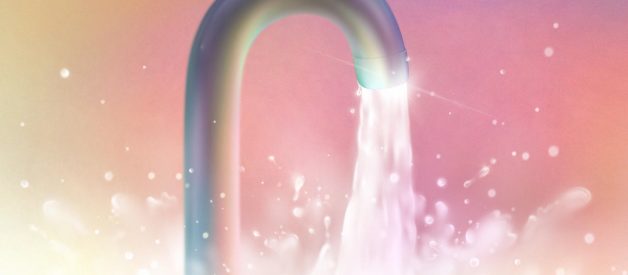
The Elemental Guide to Water
The answer is murky

?The Safe Drinking Water Act is well-intentioned, but failing to act quickly to protect us from the thousands of man-made chemicals that have entered the market.?
However, some health advocates raise concerns over the fact that the United States has not updated its federal standards for water contaminant levels in nearly 20 years. Though the water supply is tested 100 times a month, it?s not necessarily testing for modern contaminants, like new pesticides. The last chemical banned from drinking water was uranium, back in 2001. Before that, the agency hadn?t updated its list since 1994.
?The EPA?s Safe Drinking Water Act is well-intentioned, but failing to act quickly to protect us from the thousands of man-made chemicals that have entered the market,? says Genna Reed, the lead science and policy analyst at the Center for Science and Democracy at the Union of Concerned Scientists.
What contaminants could be in your tap
In October, the Environmental Working Group (EWG), a nonprofit advocacy group, released its annual Tap Water Database detailing a host of contaminants in nearly 50,000 water utilities in all 50 states.
After analyzing 32 million test results for 517 different contaminants, it was found that millions of Americans are drinking pollutants, including pesticides, arsenic, the heavy metal hexavalent chromium, and more. While water utilities are matching the EPA?s legal standards for drinking water, the water can still contain these pollutants if the amount is below the legal limit, or if the contaminants are not listed as a banned substance.
?If a system exceeds the maximum allowable concentration, intensive monitoring is required,? says Angela Hackel, an EPA senior adviser in the office of public affairs.
Hackel says the agency prioritizes health-based violations on a case-by-case level, but would not specify to Elemental why the EPA hasn?t updated its known contaminant list since 2001. ?EPA?s main goals are protecting public health and returning a system to compliance with the drinking water standards,? she says.
Alexis Temkin, an EWG toxicologist, is blunt in her criticism. ?Just because we know the majority of water utilities have federal limits and are serving legal standards of drinking water doesn?t necessarily mean the contaminants in this water aren?t harmful.?
PFAS (short for per- and polyfluoroalkyl substances), for example, are a class of chemicals linked to health issues like hormone disruption and some cancers, yet they are unregulated by the EPA. ?Not only are there are no enforceable levels for PFAS, the methods aren?t even in place for water utilities to test for more than a handful of them even if they wanted to,? says Reed.
Another contaminant is the herbicide atrazine, which is linked to cardiovascular disease and hormone interference. ?EPA and state data show that atrazine, this widely used weed killer, contaminates the drinking water of almost 30 million Americans at levels that may harm human health,? says Sarah Graddy, the deputy director of the EWG. ?Utilities are not notifying customers of the threat and that?s perfectly legal because it falls under federal guidelines.?
Contamination can also happen when water is transported. Lead pipes were installed en masse during the Industrial Revolution and are still common across the United States, especially within government buildings, schools, and other aging structures that are too costly for cash-strapped municipalities to update. Lead leaching into pipes in schools is particularly troubling since lead exposure is most concerning for the developing brain. The U.S. Government Accountability Office reports that in 2017, an estimated 13 million U.S. students attended schools with elevated levels of lead from drinking fountains and kitchen water taps. Forty-one percent of all U.S. school districts had not tested for lead in the prior year. Last year in Detroit, 16 out of 24 schools in one district shut down their drinking fountains because of elevated levels of lead.
With so much evidence of persisting problems, it should be natural to expect tougher rules in the future. Unfortunately, according to the New York Times, the EPA is planning to limit the amount of scientific research it uses to govern future pollutant-related policymaking. In other words, it will be much harder to update future water standards.
How to find out if your water is clean
Most public water suppliers are required by law to mail a drinking water quality report, sometimes called a consumer confidence report or CCR, to residents who request one. These reports provide details on where your water is derived from and what?s in it. If you rent, you may not get that report. One way to receive it is to contact your building?s manager ? or visit the EPA?s site to find your local CCR.
Another option is calling the EPA?s Safe Drinking Water Hotline at 800-426-4791. If you?re willing to wait on hold, you can use this call to ask questions about the quality and safety of your drinking water.
Prefer a more hands-on approach? The EWG tap water database aggregates utilities? water report tests so you can search by zip code, community, or contaminant here.
There are at-home tests too, which for as little as $20 can screen for contaminants like nitrate, chlorine, and other carcinogens. But the accuracy of these tests can fluctuate and no matter what you find, it can be hard to decipher the results on your own. If you have a concern (and a budget of a few hundred bucks), call a professional and send a sample of your water out to a certified water testing lab.
The best way to clean your water at home
There?s no water that?s 100% pure, so you?re likely to have some trace contaminants. Even so-called lead-free pipes can contain as much as 8% lead. For the extra cautious, public health experts advise drinking cold water from the tap and letting the water run for at least a full minute before consuming it. (Hot water releases more lead from pipes than cold water.)
But perhaps the easiest way to put your mind at ease is to invest in a water filter. ?The most commonly detected contaminants are disinfection by-products,? Temkin, the EWG toxicologist, says, ?but [those by-products] can be pretty well reduced or removed by using an activated carbon filter, which is usually found in pitcher-type filters.?
Pitcher-type filters can vary price-wise, but Temkin maintains that overall most filters do a good job of removing VOCs (volatile organic compounds), which are released from burning fossil fuels like wood or gas, or even cigarettes, and are often found in our groundwater and wells, according to the United States Geological Survey. No matter what water filter you choose, know that contaminants can build up in filters if they are not swapped out or cleaned (ideally every two months or so).
This story is part of The Elemental Guide to Water, a five-part special report on the health benefits of water, the science behind seltzer, the truth about fancy H2O, the safety of tap water, and how much water you really need to drink.
Illustrations by Shuhua Xiong



